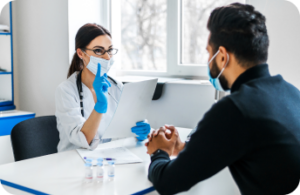Introduction:
A stroke can be a life-altering event, impacting physical, cognitive, and emotional well-being. However, with proper rehabilitation, lifestyle changes, and preventive measures, individuals can regain independence, improve their quality of life, and reduce the risk of future strokes. In this blog post, we will explore the journey of life after a stroke, focusing on rehabilitation strategies, lifestyle modifications, and essential preventive measures to promote recovery and long-term well-being.
Rehabilitation for Stroke Recovery:
Rehabilitation plays a vital role in helping stroke survivors regain lost abilities and maximize their functional independence. Physical therapy, occupational therapy, and speech therapy are key components of stroke rehabilitation. Physical therapy focuses on improving strength, balance, and mobility, while occupational therapy helps individuals regain skills needed for daily activities. Speech therapy addresses communication difficulties and swallowing problems that may arise after a stroke. Engaging in a comprehensive rehabilitation program under the guidance of trained professionals can significantly enhance the recovery process.
Cognitive and Emotional Rehabilitation:
In addition to physical rehabilitation, stroke survivors may also require cognitive and emotional rehabilitation. Cognitive rehabilitation aims to improve memory, attention, problem-solving, and other cognitive functions that may be affected by a stroke. Emotional rehabilitation involves addressing post-stroke depression, anxiety, and emotional adjustments. Support from psychologists and neuropsychologists can help individuals cope with the emotional impact of stroke and develop strategies to manage cognitive challenges effectively.
Lifestyle Changes for Stroke Prevention:
One of the most crucial aspects of life after stroke is making lifestyle changes to reduce the risk of future strokes. Adopting a healthy lifestyle can significantly improve overall cardiovascular health. This includes maintaining a balanced diet that is low in saturated fats, cholesterol, and sodium, while being rich in fruits, vegetables, whole grains, and lean proteins. Regular exercise, such as walking, swimming, or cycling, can enhance cardiovascular fitness and reduce the risk of stroke. Managing stress, quitting smoking, and limiting alcohol consumption are also essential components of a stroke-preventive lifestyle.
Medication Adherence and Follow-Up Care:
Following a stroke, adherence to prescribed medications is vital. Medications such as blood thinners, antihypertensives, and cholesterol-lowering drugs may be prescribed to manage underlying conditions and reduce the risk of recurrent strokes. It is crucial to take medications as directed by healthcare professionals and attend regular follow-up appointments to monitor progress, adjust treatment plans if necessary, and address any concerns or new symptoms promptly.
Education and Support:
Education and ongoing support are integral to life after stroke. Learning about stroke risk factors, warning signs, and preventive measures empowers individuals to take control of their health. Joining support groups or participating in stroke survivor programs can provide a sense of community, emotional support, and valuable insights from others who have gone through similar experiences. Family and caregiver education and involvement are also vital to provide optimal care and support for stroke survivors.
Conclusion:
Life after stroke is a journey that involves rehabilitation, lifestyle changes, and preventive measures. Through dedicated rehabilitation efforts, individuals can regain lost abilities and improve their quality of life. Making healthy lifestyle choices, managing risk factors, and adhering to prescribed medications are crucial in preventing future strokes. Education and support from healthcare professionals, support groups, and loved ones play a vital role in the stroke recovery process. By embracing a comprehensive approach to life after stroke, individuals can pave the way towards a healthier, more fulfilling future.




